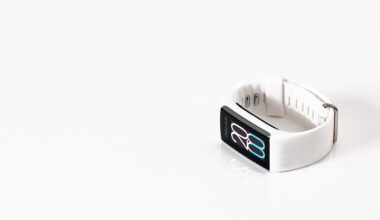Common Obstacles to Technology Detox and How to Overcome Them
Technology has become an integral part of our lives, often interfering with sleep quality. One major obstacle to a successful technology detox is the overwhelming fear of missing out (FOMO). Many people feel they must stay connected to not miss important updates or social interactions. This fear keeps them glued to their devices, particularly before bedtime. The first step in overcoming FOMO involves acknowledging the necessity of digital breaks. Setting specific times to disconnect can help individuals ease their anxiety about missing notifications. It’s essential to communicate with friends and family about your detox goals; they can provide support and understanding. Additionally, experimenting with alternatives like reading physical books or journaling can make the transition smoother. Gradually reducing screen time can also ease the overall process. Pair your detox plan with enjoyable activities that don’t involve devices. For instance, try engaging in mindfulness practices or exercising to improve not only your sleep but overall well-being. Developing a gradual and structured approach contributes significantly to reducing FOMO while enhancing sleep quality on your restorative journey.
Understanding the Psychological Impact of Screens
Another significant obstacle to technology detox is the psychological impact screens have on us. The bright screens and engaging content can lead to digital addiction, making it challenging to unplug. The blue light emitted from electronic devices can disrupt the body’s natural circadian rhythms, complicating the sleep process further. To combat this, you can establish electronic curfews, setting specific times to turn off screens and engage in pre-sleep rituals that promote serenity. Creating a calming bedtime environment free from screens is key to a successful detox. Instead of scrolling through social media or checking emails, you might consider light stretching or meditation as alternatives. Surround yourself with comforting materials like soft blankets or calming scents. Also, using apps that track your screen time can help visualize your habits and empower you to make positive changes. Over time, you will find soothing activities help facilitate your transition. Gradually reducing screen time promotes healthier sleep routines, allowing your brain to rest and rejuvenate. Setting realistic expectations and understanding the mental challenges can significantly enhance your detox journey and lead to better sleep outcomes.
Time management is often cited as a primary barrier to technology detox. Busy schedules packed with work and social commitments can make it difficult to find time to disconnect. Many people feel guilty about taking time away from work-related electronic devices, fearing it might hinder productivity. To overcome this obstacle, try scheduling specific hours for technology use, distinctly separating work, leisure, and sleep time. Implementing ‘tech-free’ zones can be an excellent way to signal to your brain when it is time to disconnect. For example, setting the dining table as a tech-free zone encourages family conversations and strengthens connections without the distraction of devices. You might also consider engaging in social activities that disallow technology altogether, such as board game nights or hiking with friends. Prioritizing your time and recognizing the importance of a balanced life can free you from tech-induced stress. Coupling detox periods with hobbies and personal interests can reinforce your commitment to disconnecting from technology. With a proactive approach towards time management, you can enhance your ability to balance technology with quality sleep, leading to a more fulfilled life.
A lack of support from friends and family members can greatly hinder efforts for a successful technology detox. When loved ones do not understand your decision to disconnect, it can lead to feelings of isolation and frustration. It’s crucial to gather a support system that encourages your objectives. Start by communicating your detox goals to those closest to you, explaining how it positively affects your mental and physical health. Encourage them to join in on the detox journey. Participating together can create a collective goal, maintaining engagement among peers while promoting accountability. For instance, scheduling regular meet-ups where devices are not allowed can encourage personal connection without technological distractions. You might also consider joining support groups or online communities focused on technology detoxing that can offer shared experiences and insights. As you progress in your detox, share successes and challenges with your support system to build camaraderie. This supportive network reassures you during tough times, motivating you to keep at your detox goals. A strong support system fosters resilience against temptations, ensuring a smoother path toward achieving better sleep.
Overcoming Addiction to Entertainment
Another frequently encountered hurdle on the path to a technology detox is addiction to entertainment content. Streaming services and social media provide never-ending gratification, making it tough to break free. One of the effective strategies for coping with this challenge is to create an engaging alternative to technology-based entertainment. Consider exploring new hobbies or rediscovering old interests that do not involve screens, such as painting, gardening, or coding. Often, people find creativity outside of technology more fulfilling. Implementing detox challenges—like going device-free for a weekend—encourages you to find entertainment elsewhere. Participating in local community events or taking classes in interesting subjects is another way to cultivate new passions. Engaging family or friends in these pursuits can enhance motivation and create memorable experiences together. Moreover, avoid autopilot consumption of content; set intentional times for watching shows or scrolling through social media. Reducing the frequency and duration of engagement can foster healthier habits. As you explore various activities, you will naturally find that your desire for digital entertainment lessens. With dedication, it is possible to overcome this addiction and prioritize restful sleep.
Physical discomfort caused by prolonged screen time can be a major barrier to technology detox. Hours spent hunched over devices can lead to back, neck, and eye strain, making it less appealing to unplug and take a break. To combat physical discomfort, it’s essential to evaluate your workspace ergonomics. Try adjusting computer screen height to eye level and invest in supportive chairs and keyboard setups. Prioritizing physical health along with mental health can significantly enhance your technology detox journey. Regularly incorporating stretching and movement can also help alleviate tension built up during extensive screen time. Establish a routine that includes simple stretches or short walks, making sure to include these intervals within your daily schedule. Developing a self-care mindset can encourage you to prioritize breaks and proper body alignment. Building this perspective allows you to reframe the occasion of extended technology use positively. You might find aligning these changes directly affects sleep quality and overall wellness within your lifestyle. A dedicated approach will ultimately enhance one’s overall health and encourage a smoother, more effective technology detox to achieve better rest.
Creating a Personal Detox Plan
Developing a personalized detox plan can help in overcoming the various obstacles of technology reliance. Begin by assessing your current habits and identifying specific areas where technology affects your sleep. For instance, tracking your screen time might reveal late-night habits that disrupt rest. After pinpointing these aspects, set realistic goals that align with your detox ambitions. Create a structured plan prioritizing your sleep patterns while reducing technology exposure. Consider incorporating tech-free zones, such as bedrooms, where technology is not permissible. This environment encourages better sleep without distractions. In addition, set aside periods throughout the day dedicated to activities disengaged from technology. Communicate these goals to your support system to foster accountability and encouragement while goal-setting. Setting measurable milestones will enable you to celebrate successes along the way, reinforcing positive behavior. Periodically reviewing your goals to ensure they remain realistic and adaptable is crucial during the detox journey. Ultimately, a well-structured personal detox plan will enhance your commitment to the cause, fostering improved sleep and overall well-being.
In conclusion, gaining better sleep through a technology detox requires overcoming numerous obstacles. FOMO can be diminished by establishing clear communication with friends and family, setting digital curfews, or engaging in enjoyable offline activities. The psychological impact of screens demands clear boundaries and a supportive environment to facilitate successful disconnection. Similarly, managing time effectively ensures a balance between obligations and recreational activities. Additionally, building a strong support system increases motivation during the detox process, as shared experiences can greatly bolster resilience. Reducing addiction to entertainment revolves around finding appealing offline versions of recreation, further decreasing dependency on screens. Addressing the physical discomfort induced by screen time is vital to emphasizing your need for proper self-care practices and ergonomics. Finally, creating a personal plan tailored to your unique lifestyle assists in keeping a clear focus while measuring progress. Implementing these steps can lead to effective detoxification from technology, resulting in improved sleep quality. Becoming mindful about technology usage can elevate well-being, promote relaxation, and foster personal growth. The commitment to this journey will ultimately enhance sleep patterns and pave the way to a fulfilling and healthier lifestyle.


